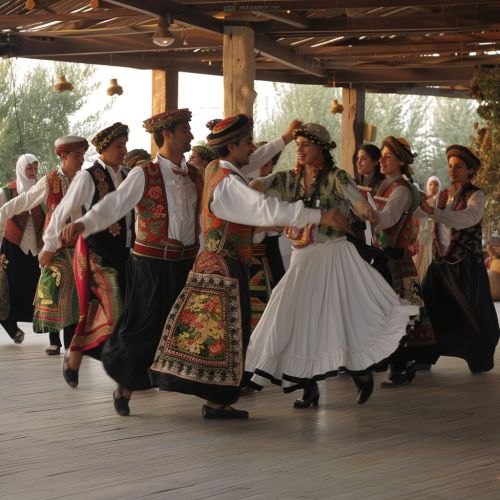Folk Dance
Overview
Folk dance, often referred to as traditional dance or ethnic dance, is a genre of dance that is integral to the culture of a specific ethnic group or region. The term "folk dance" is derived from the German word "volk", which means people. Folk dances are typically performed during social events and are often associated with agricultural activities, religious rituals, and community celebrations. Unlike ballet or modern dance, folk dance is not typically performed in a formal theatre setting, but rather in community spaces, open-air venues, or on the street.
History
The origins of folk dance can be traced back to ancient civilizations. The earliest recorded instances of folk dance were found in the archaeological sites of ancient Egypt, Greece, and Rome. These dances were often performed to celebrate harvests, weddings, and victories in battle. Over time, as societies evolved and cultures merged, the nature and style of folk dances also evolved. However, the core essence of folk dance, which is the celebration of life and community, has remained constant throughout history.


Types of Folk Dance
There are numerous types of folk dances, each unique to its region or ethnic group. Some of the most popular types of folk dance include:
Morris Dance
Originating in England during the Middle Ages, Morris dance is a form of English folk dance that is characterized by rhythmic stepping and choreographed sequences. Dancers often wear bells on their legs and wield sticks, swords, or handkerchiefs as part of their performance.
Bhangra
Bhangra is a lively folk dance from the Punjab region of India and Pakistan. It is traditionally performed during the harvest festival of Baisakhi. Dancers perform energetic movements to the beat of the dhol, a traditional Indian drum.
Flamenco
Flamenco is a passionate and expressive Spanish folk dance that originated in the Andalusian region of Spain. It involves intricate footwork, clapping, and rhythmic body movements.
Hula
Hula is a traditional Hawaiian dance that tells a story through a series of gestures and movements. Dancers often wear grass skirts and lei necklaces.
Cultural Significance
Folk dances are deeply rooted in the cultures they originate from and often serve as a reflection of the community's values, traditions, and history. They are typically performed during cultural festivals, weddings, and other significant events, serving as a form of communal celebration and unity. Folk dances also often have symbolic meanings, with each movement or gesture representing a specific aspect of the community's culture or history.
Preservation and Promotion
In the modern era, there has been a concerted effort by cultural institutions and organizations to preserve and promote folk dances. Many countries have established national dance companies that specialize in the performance and teaching of traditional folk dances. Additionally, international folk dance festivals and competitions have been organized to showcase and celebrate the diversity of folk dances from around the world.
